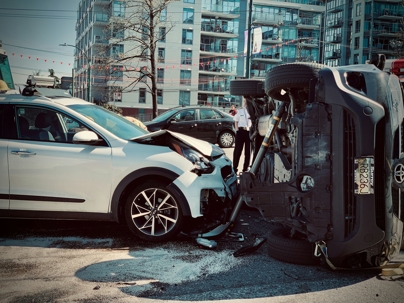Car accidents change lives in seconds. In Encino and across Southern California, we see everything from minor fender‑benders to catastrophic multi‑vehicle crashes. While every collision matters, some crash types consistently cause the most devastating injuries, the longest medical recoveries, and the most significant financial losses. This guide explains which crashes are considered the “worst,” why they are so dangerous, how liability is proven, and what injured people can do to protect their health and their legal rights.
At Arshakyan Law Firm, our Encino car accident attorneys have helped families throughout the San Fernando Valley, Ventura County, and greater Southern California rebuild after life‑altering collisions. The insights below come from years of advocating for clients in negotiations and in court.
1. Head‑On Collisions: The Most Lethal
A head‑on collision occurs when two vehicles strike each other front to front, often at speed. Because the forces combine, the effective impact can be equal to hitting a brick wall at highway speed. Even with modern crumple zones and airbags, the human body is not built to tolerate that amount of kinetic energy.
Why they’re so dangerous:
- Massive energy transfer produces traumatic brain injuries, internal bleeding, and multiple fractures.
- Occupants experience “secondary collisions” with the interior of the vehicle even if airbags deploy.
- Lane‑departure events—wrong‑way entries, fatigue drift, or intoxication—often mean the at‑fault driver never brakes.
Common causes:
- Impaired driving (alcohol, drugs, or a dangerous mix of medications).
- Drowsy driving on late‑night commutes in the Valley.
- Wrong‑way entries from a surface street onto the freeway.
- High‑speed passing on two‑lane canyon roads.
Case study (Encino/101 Freeway)
Just east of the 101/405 interchange, a wrong‑way SUV entered the eastbound lanes near the Haskell Ave on‑ramp and struck a compact sedan head‑on. The sedan driver, a Valley teacher, suffered a brain bleed and multiple pelvic fractures. Our investigation pulled traffic‑camera footage and bar receipts proving the SUV driver had been overserved. We pursued a claim against the driver and a dram‑shop claim against the establishment, ultimately resolving for policy limits plus a confidential contribution that funded a long‑term care plan.
2. Side‑Impact (T‑Bone) Collisions: Minimal Protection, Maximum Harm
T‑bone crashes typically happen at intersections when one driver runs a red light, rolls a stop sign, or turns left across oncoming traffic. Doors and side structures provide less protection than the front and rear of a vehicle, and side airbags may not fully cover the chest, pelvis, and head.
Why they’re so dangerous:
- The striking vehicle intrudes directly into the occupant space.
- Impact points are at torso and head height, causing rib fractures, lung punctures, and TBIs.
- Smaller sedans and older vehicles have less side‑impact protection.
Encino case study (Ventura Blvd at Balboa Blvd)
A delivery van accelerated to beat a yellow, entering the intersection after the light turned red and driving into the driver’s side of a family sedan. Mom—belted, with an 8‑year‑old in a booster—sustained a complex pelvic ring fracture and a moderate TBI. We obtained video from a nearby business and the van’s telematics, proving the red‑light violation and speed. The case settled for $2.1 million, covering past medical bills, home modifications, wage loss, and a life‑care plan.
3. Rollover Crashes: Vehicle Dynamics Turn Violent
Rollovers are especially lethal for SUVs, vans, and pickups with a higher center of gravity. A sudden steering input, tire blowout, or edge‑drop‑off can initiate a trip or un‑tripped rollover. Occupants may be partially ejected, roof‑crushed, or struck repeatedly inside the cabin.
Risk factors:
- High center of gravity and overloaded cargo or roof racks.
- Worn or defective tires, especially in summer heat on the 118, 170, and 405 corridors.
- Overcorrection after wheels drop off the roadway edge.
Calabasas Canyon case study
On Mulholland Highway, a young driver swerved to avoid debris, over‑corrected, and the SUV rolled three times down a slope. The rear‑seat passenger suffered a thoracic spinal fracture. Our experts traced the initiating cause to a tread‑separated rear tire and a defective belt‑edge design. A product‑liability claim against the tire maker resolved for a multi‑million‑dollar confidential settlement, funding adaptive equipment and vocational retraining.
4. Multi‑Vehicle Pileups: Chain Reactions with Complex Liability
Fog, glare, smoke from brush fires, and sudden braking in heavy traffic can trigger chain reactions on Southern California freeways. A single loss of control can lead to a dozen impacts in seconds.
Why they’re among the worst:
- Secondary impacts compound injuries, especially whiplash‑to‑disc injuries.
- Vehicles can catch fire or leak hazardous fluids, delaying rescues.
- Liability can involve several drivers, a commercial carrier, and even roadway maintenance entities.
Simi Valley/118 Freeway case study
Rain created a thin film of oil on the pavement. When a pickup hydroplaned and spun, trailing drivers braked hard; several were following too closely and struck the vehicles ahead. We reconstructed speeds using event‑data recorders from four vehicles and CHP diagrams, allocating fault proportionally and securing recoveries for each injured client despite limited insurance.
5. Rear‑End Collisions: Common but Not “Minor”
Rear‑end crashes are often dismissed as “just whiplash,” yet many clients present with herniated discs, nerve impingement, and headaches that persist for months. Injuries are worse when an SUV or truck strikes a smaller car or when the first impact pushes the victim into another collision.
Typical causes:
- Texting, streaming, or looking down at navigation.
- Abrupt stop‑and‑go traffic on the 101 through Studio City and Universal City.
- Speed differentials during lane‑changes.
Studio City case study
Stopped in late‑afternoon traffic, our client was hit at approximately 45 mph by a distracted driver. Cervical MRI showed a large C5‑C6 herniation. Two surgeries were necessary. Phone records and an admission in the at‑fault driver’s statement established distraction. We resolved the case for $750,000—covering medical expenses, wage loss, and therapy.
6. Large Truck and Commercial Vehicle Crashes: Catastrophic Forces
A fully loaded tractor‑trailer can weigh up to 80,000 pounds. At highway speed, stopping distance doubles or triples compared to passenger cars. Fatigue, deadline pressure, and maintenance lapses increase risk.
Key hazards:
- Wide blind spots (“no‑zones”).
- Tire and brake failures on grades.
- Employer negligence: unrealistic schedules and poor supervision.
Ventura County case study
A box truck drifted from its lane on Highway 118 when the driver microslept. The impact left our client with incomplete paraplegia. Our team obtained driver‑log data, cell‑tower pings, and ECM downloads showing hours‑of‑service violations. A jury returned a $3.8 million verdict, later enhanced with costs and interest.
7. Pedestrian and Cyclist Collisions: Zero Protection
When a multi‑ton vehicle meets an unprotected body, the results are often catastrophic. Crosswalk violations, visibility issues at dusk, and dooring incidents in bike lanes produce severe fractures and head trauma even at modest speeds.
Encino crosswalk case study
Near Balboa Park, an elderly man with the right of way was struck by a driver looking at a smartwatch notification. We recovered $1.2 million, including funds for in‑home care and future medical monitoring.
8. DUI, Drug‑Impaired, and Distracted Driving: Preventable and Devastating
One of the most heartbreaking realities is how preventable many of the worst crashes are. Alcohol, cannabis, sedating prescriptions, and screen use all degrade reaction time and judgment.
Sherman Oaks wrongful death case study
A college student riding home with friends on Sepulveda Blvd was killed when a drunk driver ran a red. Toxicology showed a BAC nearly three times the legal limit. In addition to claims against the driver, we pursued negligent entrustment against the vehicle owner for lending the car despite prior DUIs. The case resolved before trial, and the family created a memorial scholarship.
What “Worst” Really Means—Injuries and Damages
The worst crashes cause the worst outcomes: traumatic brain injuries, spinal cord injuries, complex orthopedic fractures, severe burns, and psychological trauma. From a legal standpoint, “worst” also relates to damages—the full, real‑world losses you suffer:
- Medical bills (ER, surgeries, rehab, medications, mobility aids).
- Lost wages and diminished earning capacity.
- Pain, suffering, and loss of enjoyment of life.
- Home modifications and vehicle replacements.
- Wrongful death damages for surviving families.
How Liability Is Proven
Our Encino accident lawyers build cases with evidence that insurance companies respect:
- Police reports and 911 audio.
- Dash‑cam, traffic‑cam, and nearby business video.
- Event‑data recorder downloads and telematics.
- Accident‑reconstruction modeling.
- Medical expert opinions establishing causation and future care needs.
Frequently Asked Questions
What if I’m partially at fault?
California’s comparative negligence rules allow recovery even if you share some blame; your compensation is reduced by your percentage of fault.
Do I have to speak to the other driver’s insurer?
You are not required to provide a recorded statement. Speak with a lawyer first so you don’t accidentally harm your claim.
What if the other driver has minimal insurance?
We look for additional sources: employer policies for on‑the‑clock drivers, manufacturer liability for defects, public‑entity claims for a dangerous roadway, and your own UM/UIM coverage.
What to Do After a Serious Crash in the Valley
- Call 911 and get medical help—even if you feel “okay.” Adrenaline masks pain.
- Photograph the scene, vehicles, skid marks, debris, and visible injuries.
- Exchange information and collect witness contacts.
- Seek prompt medical evaluation and follow treatment plans.
- Contact experienced Encino car accident lawyers to protect your rights.
How Arshakyan Law Firm Helps
We are trial‑ready advocates who negotiate from a position of strength. Our bilingual team serves Encino, Tarzana, Sherman Oaks, Woodland Hills, Calabasas, and communities across Southern California. We coordinate medical care, preserve evidence, and manage insurers while you heal.
- Strategic investigations using experts in reconstruction, biomechanics, and life‑care planning.
- Transparent communication—updates you can count on.
- Results that help clients rebuild their lives.
Conclusion and Call to Action
Head‑on, side‑impact, rollover, truck, and multi‑vehicle pileups are widely considered the worst car accidents because they combine high forces, limited occupant protection, and complex liability. If you or a loved one was hurt in Encino or anywhere in Southern California, you do not have to face insurers alone.
Call (818) 650-9985 for a free, confidential consultation with Arshakyan Law Firm. We will listen, investigate, and fight for the compensation you deserve. We are in your corner!

